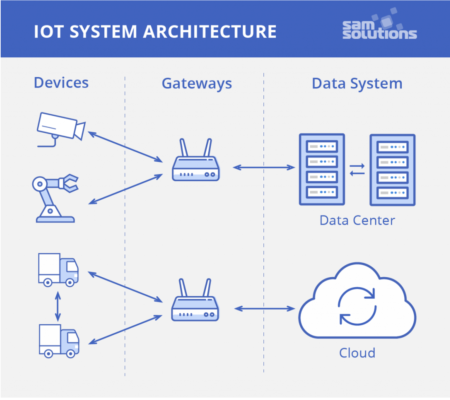 Source: https://www.researchgate.net/figure/IoT-Standard-Architecture-16_fig4_327600215
Source: https://www.researchgate.net/figure/IoT-Standard-Architecture-16_fig4_327600215
1. IPv6
Internet Protocol version 6 (Ipv6) is the newest version of the Internet Protocol (IP), which is the concept of communications protocol that provides an identification and location system for computers on networks. The main purposes of an Internet Protocol are routing traffic across the Internet, packet-switched internetworking, and allowing end-to-end datagram transmission. IPv6 was developed to deal with the problem of IPv4 address exhaustion and is expected to replace IPv4.
Devices with Internet connection are assigned a unique IP address, however, since the rapid growth of the Internet in the 1990s, far more addresses than the available space of IPv4 are needed, which ultimately lead to the development of IPv6. IPv6 also provides other technical benefits besides a larger addressing space. Multicasting, an optional but commonly implemented feature in IPv4, received changes and improvements in IPv6. Multicasting allows the transmission of a single packet to numerous destinations with only one send operation. Furthermore, the packet header in IPv6 is simpler than the IPv4 header, and therefore, the process of packet forwarding by routers has been simplified. Other aspects including device mobility, configuration, and security have been considered in the development and implementation of this protocol as well.
 Source: https://www.sam-solutions.com/blog/internet-of-things-iot-protocols-and-connectivity-options-an-overview/
Source: https://www.sam-solutions.com/blog/internet-of-things-iot-protocols-and-connectivity-options-an-overview/
2. 6LoWPAN
6LoWPAN stands for IPv6 over Low power Wireless Personal Area Networks. The concept was developed based on the idea that applying the Internet Protocol even to the smallest devices is necessary, and low-power devices with limited processing capabilities should also become parts of the Internet of Things. The 6LoWPAN protocol enables multiple features including different networking topologies such as star and mesh, low bandwidth (250/40/20 kbps), low power consumption, typically battery-operated, relatively low cost, scalable networks, reliability, mobility, and long sleep times.
3. RPL
Routing protocol for low-power and lossy networks (RPL) is a routing protocol for wireless networks with low power consumption. The fundamental concept of this protocol is based on distance vectors and while it operates on IEEE 802.15.4, optimization has been made for multi-hop and many-to-one communication, with additional support for one-to-one messages.
RPL can support various link layers, including those with limitations, with potential losses, or that are used in devices with limited resources. This protocol can quickly and efficiently create network routes, share routing knowledge and adapt the topology.
4. 6TiSCH
In recent years, Wireless Sensor Networks (WSNs) have gained interest with the introduction of application areas such as industrial internet, m-Health, and Smart Grid. WSNs consist of sensors with wireless capability operating autonomously and reporting data to a central unit. To enable low power, high reliability, and deterministic WSNs, 6TiSCH protocol has been proposed which uses Time Slotted Channel Hopping (TSCH) MAC with IPv6 addressing.
Low-power devices utilize TSCH to communicate over a wireless link. It is designed for low-power and lossy networks (LLNs) with the main purpose of providing a reliable media access control layer. TSCH can be viewed as a combination of Time division multiple access and Frequency-division multiple access mechanisms as it uses diversity in time and frequency to provide reliability to the upper network layers.
5. WoT
Web of Things (WoT) refers to a set of standards that aims at enabling interoperability across IoT Platforms and application domains. The WoT building blocks provide a way to implement systems that conform with the WoT architecture including WoT Thing Description (TD), WoT Binding Templates, WoT Scripting API, and WoT Security and Privacy Guidelines.
The key component of the WoT building blocks is the WoT Thing Description which describes a virtual or physical device (Thing). It defines a model of a Thing and can be considered as the main entry point for a Thing. It also describes all available actions, events, and properties of a Thing, as well as all available security mechanisms to access them.
6. oneM2M
 Source: https://www.avsystem.com/blog/iot-protocols-and-standards/
Source: https://www.avsystem.com/blog/iot-protocols-and-standards/
oneM2M is a global project established in 2012 which aims at becoming a long-term solution for IoT deployment by the world’s leading standards development organizations. The vision of this project is to standardize the interoperability between IoT devices. Thanks to oneM2M technology, fragmentation in the IoT world is gradually removed. Manufacturers all over the world are building IoT devices, gateways, and platforms, deploying IoT solutions and data-exchange systems based on the oneM2M standard.
oneM2M Common Service layer Functions (CSF’s) provide identification of users and applications, authentication and authorization of users and applications, end-to-end data encryption, remote provisioning, and service activation, device management, connectivity setup, and data transmission scheduling, data aggregation, buffering in case of losing connectivity and synchronization when connectivity is resumed, group management, application, and data discovery functions.
7. Conclusion
The explosions of Internet-connected devices and IoT networks have enabled the development of numerous standards and protocols at a very fast pace. The IoT ecosystem and its additional technologies are expected to expand even faster in the coming years, therefore interoperability will become one of the hottest topics as multiple IoT standards and protocols are being developed and deployed.
